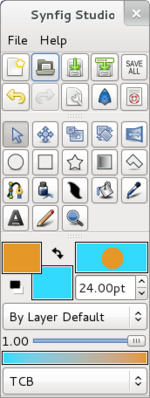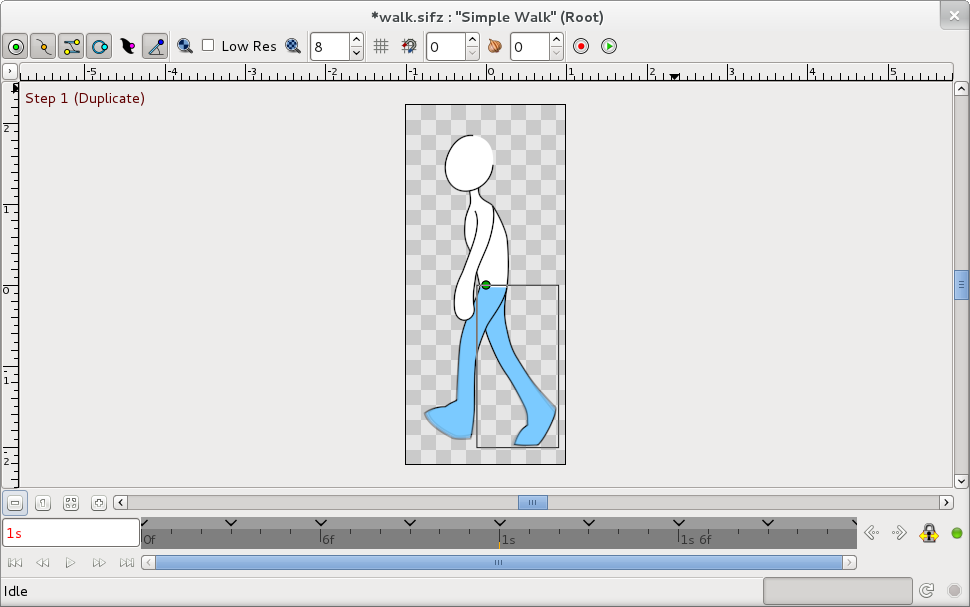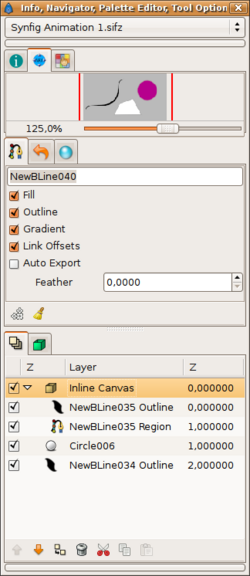Interfaccia
|
Warning! This page contains outdated information. The release of Synfig Studio 0.64.0 introduced new terminology and this translated page needs to be updated according to original English text. You can help updating this page - see instructions here. Thank you! |
Synfig Studio non si avvia in una sola finestra, ma apre un certo numero di finestre singole. Se hai familiarità con The GIMP, questo ti sarà familiare. Qui troverai una breve introduzione ai differenti elementi che ti si presenteranno all'apertura di Synfig.
Contents
La Casella Strumenti
La Casella Strumenti è la finestra principale di Synfig: anche se si hanno diversi progetti aperti, ci sarà solo una casella degli strumenti.
La finestra è divisa in tre aree o tavolozze:
- L'area superiore contiene i pulsanti con accesso alle funzioni sui file standard: nuovo file, apri file, salva (tutti i) file (con un nuovo nome), annulla e ripristina così come l'accesso alla finestra di dialogo impostazioni e il sistema di help.
- Nell'area sottostante troviamo gli strumenti che ti permettono di creare e manipolare gli oggetti (o meglio: layers, in quanto ogni oggetto è situato in un piano). Puoi trovare una descrizione dettagliata degli strumenti here.
- The lowest palette contains the default settings for new layers: fore- and background colors, line width, opacity and layer mode.
The Canvas window
Once you have opened a file or created a new project (e.g. via the buttons in the toolbox) you'll see the canvas window. This is where you'll create your animation!
Whereas most graphics apps have a set of menus at the top of the screen, the top of the MDI window, or the top of the drawing window, Synfig has a caret: the little black triangle in the upper left corner of the canvas. Beneath are all the menus you would expect and that allow you to access most of Synfig's features.
The area with the grey check-board pattern is your working area in which you can create elements/layers and manipulate them.
The timeline that you can see in the picture here only appears when you have defined a non-zero duration in the settings dialog of your project. To the left you can see the number of the current frame and on the right side two buttons to switch the animation status and to lock/unlock the keyframes. The Basi per l'Animazione Tutorial gives a good introduction on how to work with this buttons.
In the picture above there are three elements on the canvas, the black curve - called BLine - is selected. The little coloured dots control the curve and are called ducks.
The third window contains again three areas, each of which can show different panels: in this picture the Navigator Panel, the Tool Options Panel and the Layers Panel are active.
You can access detailed descriptions of the other panels here.
The Parameter and Time Track Panel
The fourth and last window shows the Params Panel, where you can find detailed parameters and settings for the active element like colour, width, opacity, location and so on. To the right is the Time Track Panel that allows you to create and modify Waypoints.



